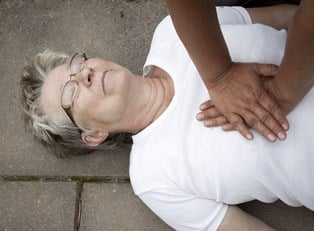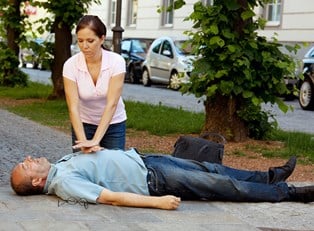Cardiopulmonary resuscitation (CPR) is a technique used to treat someone after his or her heart stops beating in an emergency. The technique uses chest compressions and rescue breathing in order to keep oxygenated blood flowing to the brain and organs. This can save the life of a person and prevent serious brain damage. Performing CPR requires a few steps that should be done in sequence and repeated until professionals arrive or the person starts breathing again.
- Assess the patient and call for help.
You only have a few minutes to act once a person’s heart stops beating. You should first shake the person and yell loudly to see if the individual wakes up. You should check quickly for a pulse. If more than one person is present, then the other individual should call for emergency help immediately while you start CPR. If you are the only person there, then you should perform CPR for 10 minutes and then call emergency services for help. Only perform CPR if no pulse is detected.
- Chest Compressions
The first step is to start performing chest compressions. Get the person on his or her back on a firm surface or the ground. Kneel beside the shoulders and neck. Place a hand on the chest between the nipples with your palm down. Place your other hand on top of the first. Use all your upper body weight and the strength in your arms to push the chest down two inches. You need to do this around 100 times every minute. If you have never been fully trained in CPR, then this is all you should attempt. This is called hands-only CPR.
- Clear the Airways
If you have had previous CPR training, clear the airways after 30 chest compressions. Check if the individual is breathing normally first. If not, then you should angle the head back and pull the chin forward. This opens the airways so that you can introduce oxygen into the body. You should never try to do this step unless you have had formal training in the past.
- Rescue Breathing
After the airways are clear, you need to start rescue breathing if you have had previous training. If you have not had training, then you should simply continue chest compressions. Start by pinching the nose closed. Press your mouth against the mouth of the other person. Create a seal with your lips and exhale deeply. If the chest of the patient rises, then do this a second time. If the chest does not rise, then try to clear the airways and perform a second breath. Return to chest compressions immediately after this. You should do rescue breathing after every 30 chest compressions. Continue these cycles until the person starts breathing or until medical professionals arrive.
Learning and Practicing CPR
There are many different places available to learn and practice CPR. You can find classes to become certified through hospitals, colleges, and community centers. There might be local government programs in your area every year. Some businesses and advocacy groups provide CPR training. You can usually attend some of these classes in order to practice CPR if you have started to become rusty.



